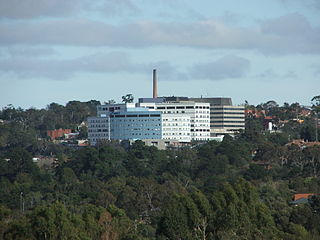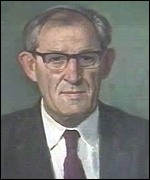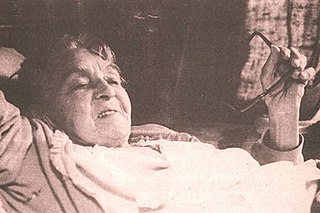
Mercy Hospital for Women, is based in Heidelberg adjacent to the Austin Hospital. The hospital offers obstetric, gynaecological and neonatal services and has one of only four neonatal intensive care units in Victoria. The Neonatal Intensive Care Unit is co-located with the Special Care Nursery and collectively they care for some of Victoria's most unwell babies. The hospital was opened in 1934.

Greenlane is a central isthmus suburb in Auckland, New Zealand. It is bounded by Epsom to the west, Newmarket to the north, Remuera to the east and One Tree Hill to the south.

Ian Donald was an English physician who pioneered the diagnostic use of ultrasound in obstetrics, enabling the visual discovery of abnormalities during pregnancy. Donald was born in Cornwall, England, to a Scottish family of physicians. He was educated in Scotland and South Africa before studying medicine at the University of London in 1930, and became the third generation of doctors in his family. At the start of World War II, Donald was drafted into the Royal Air Force as a medical officer, where he developed an interest in radar and sonar. In 1952, at St Thomas' Hospital, he used what he learned in the RAF to build a respirator for newborn babies with respiratory problems.

George Herbert Green, B.A., BSc, M.B., Ch.B.,, M.R.C.O.G.(Lond.), was a New Zealand Obstetrician and Gynaecologist who led the National Women's Hospital Cervical Cancer Unit as Professor through the 1960s and 1970s and became notorious for conducting an alleged unethical experiment that was the subject of the Cartwright Inquiry.

Aberdeen Maternity Hospital (AMH) is a specialist maternity hospital in Aberdeen, Scotland. Between 4,000 and 5,000 babies are born at AMH each year. The hospital is located in the Foresterhill area of Aberdeen and serves the region of Grampian as well as the islands of Shetland and Orkney. It is managed by NHS Grampian.

Sir Dugald Baird FRCOG was a British medical doctor and a professor of obstetrics and gynaecology. Baird was most notable and influential in calling for the liberalising of abortion. In his delivery of the Sandoz lecture in November 1961, titled the Fifth Freedom, he advocated for freedom from the tyranny of fertility.

Tsan Yuk Hospital is maternity hospital is located on 30 Hospital Road, Sai Ying Pun on Hong Kong Island, is a public hospital in Hong Kong, It was specialising in obstetrics and gynaecology. It also operates as a teaching and training hospital for the medical and nursing students of Li Ka Shing Faculty of Medicine of the University of Hong Kong.

Auckland City Hospital is a public hospital located in Grafton, Auckland, New Zealand. It is the largest hospital in New Zealand, as well as one of the oldest medical facilities in the country. It provides a total of 1,165 beds. It was established in 2003 as an amalgam of Auckland Hospital, Starship Hospital, Green Lane Hospital and National Women's Hospital. Public hospitals in Auckland have been run by Te Whatu Ora – Health New Zealand since 2022.

The Sloane Hospital for Women is the obstetrics and gynecology service within NewYork-Presbyterian Hospital and the Department of Obstetrics and Gynecology of the Columbia University College of Physicians and Surgeons (P&S) in New York City. It was founded in 1886 with Columbia P&S as a training and treatment center for obstetrics. It has provided over 100 years of obstetrical care. The hospital is located within Morgan Stanley Children's Hospital.

Sir Graham Collingwood "Mont" Liggins was a New Zealand medical scientist. A specialist in obstetrical research, he is best known for his pioneering use of hormone injections in 1972 to accelerate the lung growth of premature babies. This made it possible for many preterm babies with lung problems to survive.
Hilda Margaret Northcroft (1882–1951) was a New Zealand medical doctor and community leader.
Nina Catherine Muir was a New Zealand medical doctor.
Doris Clifton Gordon was a New Zealand doctor, university lecturer, obstetrician and women's health reformer. She was known as 'Dr Doris', famous for her work in rural general practice, for raising the status of obstetrics, improving obstetrics education of medical students and doctors, and working for the welfare of mothers and children.
Amelia Bagley was a New Zealand hospital matron, midwife and nursing administrator. She was born in Dunedin, New Zealand on 2 October 1870.
The Karitane Hospitals were six hospitals in New Zealand run by the Plunket Society, located in Auckland, Christchurch, Dunedin, Invercargill, Wanganui and Wellington. They were established as training hospitals for Karitane nurses and cared for babies with malnutrition and other dietetic complaints, and premature babies. They also offered mother care training and assistance. The first hospital opened in 1907 and the hospitals were closed between 1978 and 1980 due to financial difficulties and changes in society and maternity services.

Cornwall Hospital was constructed in Cornwall Park, Auckland, New Zealand during World War II by the American Army and was named the 39th United States General Hospital. It accommodated casualties from the war in the Pacific. From 1945 it was leased by the Auckland Hospital Board to provide maternity and geriatric services and closed in 1975.

The St Helens Hospitals were maternity hospitals located in seven New Zealand cities. They were the first state-run maternity hospitals in the world offering both midwifery services and midwifery training. The first hospital opened in 1905 in Wellington and the last one in Wanganui in 1921. The services of the St Helens Hospitals were gradually incorporated into other hospitals and the last hospital to close was in Auckland in 1990.

Vera Jane Ellis-Crowther was a Liverpool-born New Zealand nurse and midwife. An early advocate for the use of anaesthetic during childbirth, Ellis-Crowther operated the Waitemata Obstetric Hospital in Glen Eden, West Auckland from 1945 to 1954. Later in life, Ellis-Crowther became an advocate for home birthing, delivering over 1,000 home birth babies in New Zealand.

Joan Elsa Donley was a Canadian-born New Zealand nurse and midwife. Donley was a key figure who shaped midwifery and the home birth movement in New Zealand.

Greenlane Clinical Centre is a public hospital in Greenlane, Auckland, located on Green Lane West, near Cornwall Park. The hospital is administered by the Northern division of Te Whatu Ora providing outpatient and day surgery services to the Auckland Region. The healthcare facilities at Greenlane have seen many notable developments in New Zealand's healthcare.

















